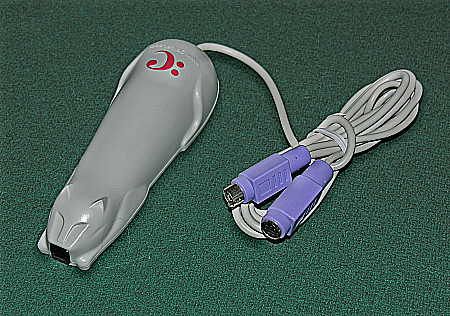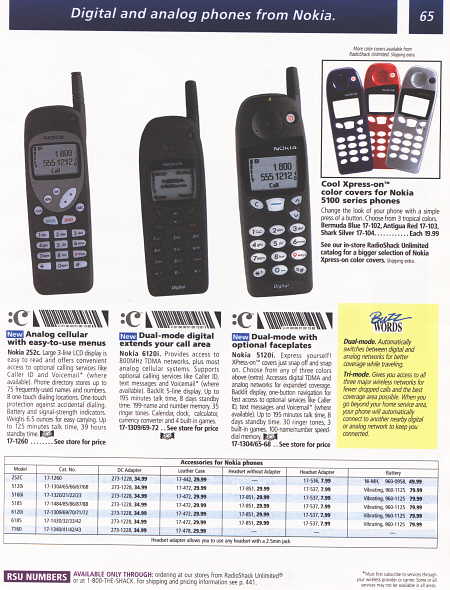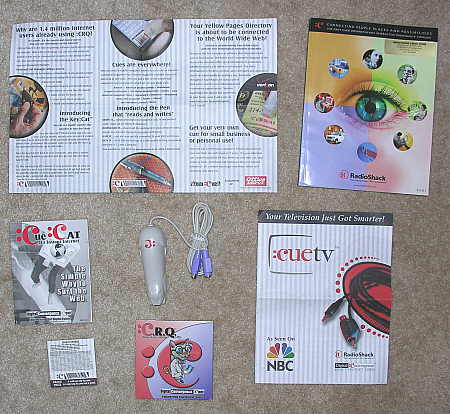I found this curious looking creature nesting in the back recesses of a little used file cabinet in the basement. I know what it is, but can you identify it?

(Hint: it never caught on, and is now extinct)
UPDATE WITH SOLUTION
The item above, as pointed out by David, is known as a :Cue:Cat. This device was produced by a company called DigitalConvergence.:Com Inc. The idea was to provide every computer with this modified bar code reader, and convince business partners to include special :Cue codes in various printed matter which would then lead to a specific web page on the internet. The :Cue:Cat was distributed by Radio Shack stores for free, and in the year 2000, Radio Shack supplied their Master Catalog with the special :Cue barcodes, as shown here –

The entire installation and promotion kit that was distributed by Radio Shack stores is pictured below, which included various teaser promises of wonderful applications to come.

Three of the more noteworthy uses that DigitalConvergence was hoping to implement with this device were 1) a link between television and the computer using a special :CueTV cable. This was an audio cable with a RCA type pass-through connector at the television end, and sound card connector at the other end. When properly configured, the audio system on the TV was supposed to feed web-page links directly to a connected computer, via specially encoded transmissions contained in the audio signal. So, while watching TV, one could theoretically view unlimited program information simultaneously on the computer screen.  Instead of the hard-wired connection, one could also opt to purchase a Wireless Audio-Link from Radio Shack. 2) a web-based, consumer accessible UPC code database linked directly to a unique web-page for each UPC code in existence. The idea behind this was simple – by simply scanning the bar-code from any commonly available product, one would be instantly transported to a web-page relevant to the individual product. 3) a personal :CueCode available to any consumer who wanted to register for one.  This would allow any individual the ability to direct someone to their personal web site by including the personal :CueCode on business cards, letterheads, invitions, etc. The personal :CueCode was to be marketed exclusively by Office Depot stores.
For those people on the go, DigitalConvergence had two mobile solutions as well, one in the form of a keychain fob code reader and the other in the form of a Cross pen with a built in reader. Each of these readers could store up to 300 :Cue:Codes, and by simply touching the reader to a device called an OptiLink (sold seperately), the information would be uploaded to the computer.
My own experience with the :Cue:Cat was not quit as rosy as DigialConvergence would have had me believe. After installing the driver software and hardware, I took the Radio Shack catalog and tested some of the links I found within it. Most of the links returned a 404 File not found) error message. Of the links that worked, I found that most of them simply parroted the information I had before me on the printed page. Similarly, when attempting to scan the UPC code of various products, I experienced mostly failure. It might well be that this was a result of rushing the concept to market before all of the required pieces were in place. Regardless as to the reasons, it left such a poor impression on me that I uninstalled the software, and all of the materials that you see here have sat dormant in the recesses of my file cabinet until now.



My guess is that it is a Cat Mouse…
Ah! The CueCat – one of the great dot-com business blunders.
The fact that you have one tells me that circa 2000, you either were subscribed to Wired, or made a purchase at Radio Shack.
The good news is that you can hack the cuecat to do all sorts of useful things – see http://users.conninc.com/databasement/cuecat.html
Darn, David beat me to it; I’ll have to get up earlier!
I have one of these CueCat’s as well, used to read bar codes from my CD collections. It has been extremely useful.
However, eBay was my avenue of purchase.
Congratulations David, you win the :Cue:Cat pictured in the photos. I’ll even include all the materials that came with the :Cue:Cat.
I thought that this might take a few days for someone to come up with the answer, but HOURS? I will have to find something a lot more challenging next time!
MrC – You might just be one of the few people in existence who actually paid money for a :Cue:Cat. I would have sold you mine had I known you wanted one bad enough to purchase one on eBay, but it’s too late now, David just won it!
Hal, I actually knew it wasn’t a Mouser Cat as it has two tails; but I’m wondering if you know of some simple software/hardware that would allow me to label my spilled collection of 35mm slides with a barcode and then allow me to use that to sort them back into their chronological order using barcode technology.
I know I could simply label them from 1 to X with a fibre tip pen and then enter their details into a database, but I need an excuse to play with bar code technology!!
I see MrC has put a Cue Cat to use to sort his CD collection. Is he in the habit of dropping a full cabinet of CDs?
Given your review of the said article I guess I shouldn’t immediately go to eBay to buy one; but Mr C may have a different opinion.
Tj
Tjilpi – The CueCat wand did a fine job of reading the bar codes it was presented with. The problems resided in the servers and software that DigitalConvergence was utilizing to provide the functionality that they promised. By utilizing the hardware hack that David provided in his link, the CueCat can be made to perform exactly like any other wand type bar code scanner.
Regarding using bar code technology to catalog your slides, it can be done easily using a couple of methods. The first is to use a bar code printing program that allows for sequential bar code numbering, and print the labels yourself. Avery and other companies produce self-adhesive labels in sizes appropriate for 35mm slide mounts.
The second option is to buy pre-printed bar code labels (sequentially numbered) in the correct size. Many companies provide these preprinted labels.
I had a client years ago who owned a stock photo agency, and he wanted to do the same thing you would like to do. I did the database programming for him, and the system worked well after we worked the bugs out. One of the items encountered on the learning curve is that all labels are not created equal. What we discovered (the hard and expensive way) was that it is IMPERATIVE to test the specific label properties under the conditions you intend to use the labels in. Certain adhesives will fail after prolonged storage within the confines of transparent slide storage pages. Some adhesives will fail when exposed to the heat of a projection system. Some labels are prone to curl up at the edges, which can lead to catastrophic slide destruction when the slide is run through projection or viewing equipment. Slides with proper labels can usually be used with Kodak Carousel standard (80) slide trays, but not with Kodak Carousel high-capacity (120) slide trays. And on and on it goes. So if you decide to take this route – TEST, TEST, TEST!
Paid $21.50 for it no less, about 1 year ago. For me, it was worth every penny – it saved hours of manual input.
Tjilpi – As you can see from my comment above, it was very worthwhile. The modified version of the device simple translates the barcodes into alpha-numeric text, equivalent to entering the data via your keyboard. Any field that accepts text will accept the input from the cuecat.
ps. never dropped the CD cabinet; what a mess that would have been! And good riddance to those unsightly cabinets anyway.
I didn’t read Hal’s comments very carefully before I answered. I did not use any additional software with the device; generally this type of accompaning software is garbage and is more trouble that its worth.
The device is recognized by Windows XP as a simple input device, like a keyboard. No additional software is required; just plug it in, and it will start translating barcodes and outputing text.
Thanks for that. I might just go hunting for a Mouser Cat. My slides vary from plastic Agfa mounts to Kodak cardboard so finding the right stickiness for my slide mounts might be my first task. My projector is an Agfa with a slide/rack system rather than a carousel. No lid on the racks – hence the ability to tumble a lot of slides onto the floor!! Projector lens is very good however.
PCWorld just named DigitalConvergence’s CueCat the 20th worst tech product of all time. Not the device itself, but the software and “solution” it aimed to provide.
http://www.pcworld.com/reviews/article/0,aid,125772,pg,5,00.asp
That’s a funny coincidence that PCWorld just published the list with the CueCat included. I was aware that there was some clamor over DigitalConvergence’s gathering of personally identifiable information, but I did not know that there was a breach of their database by hackers. Interesting indeed. Maybe it’s a good thing this didn’t take off as planned.